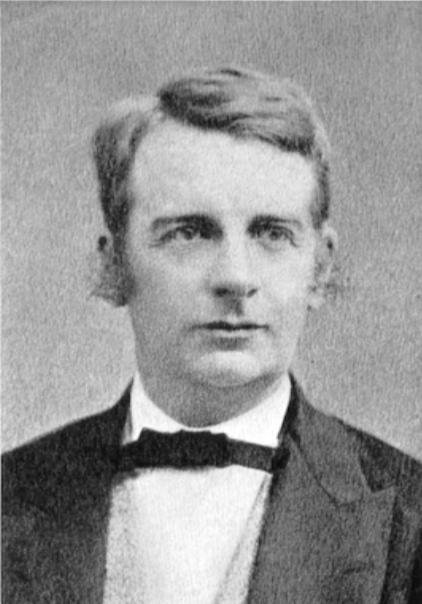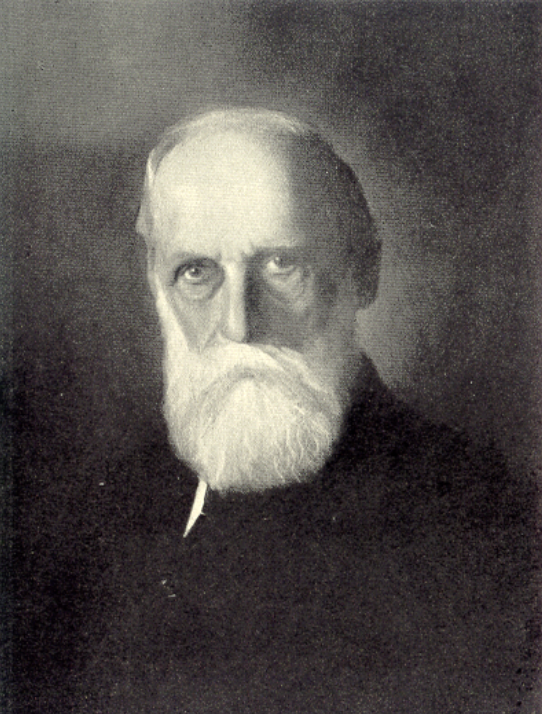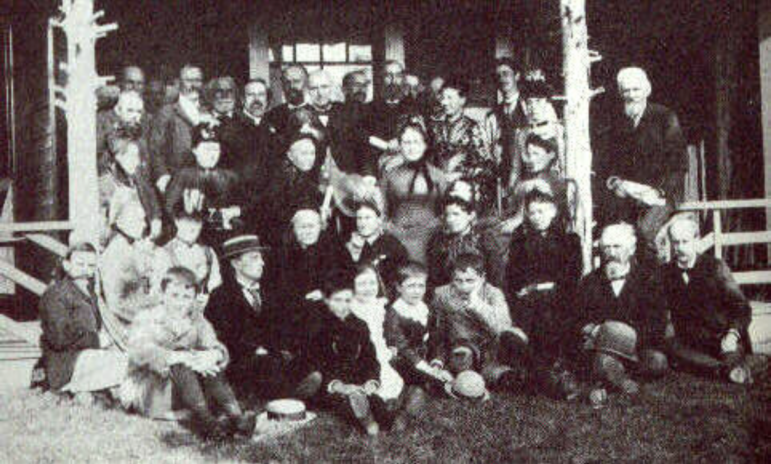
The following article is part of a series on local history provided by the Historical Society of Watertown. It was written by Joyce Kelly, Board member of the Historical Society of Watertown. Joyce writes articles for the newsletter and is the newsletter editor. This was published in our February 1999 newsletter, “The Town Crier.”
THE FORMING OF THE HISTORICAL SOCIETY OF WATERTOWN
Many of you have been members of the Historical Society for years, and several of you are new members. We’re sure you have wondered how the Society originated.
The library in the Edmund Fowle House, our headquarters, has a wealth of written accounts of meeting minutes and articles documenting, in detail, the events leading up to the development and continuing evolution of this wonderful establishment.
This is a brief background to the formation of this longstanding and dedicated organization. The Historical Society of Watertown was formed in 1888 by Dr. Alfred Hosmer, Rev. Edward A. Rand, and Solon F. Whitney, who was our town librarian. Dr. Hosmer, as you may remember from our story on Harriet Hosmer, was Harriet’s cousin.
Alfred Hosmer had a great interest in the area he was born and raised in. He felt it was urgent to “call attention to the importance of sifting the traditions which have been handed down, of determining, while possible, the unwritten facts so fleeting in our history, and especially, of decided and combined efforts to preserve them.”
The initial meetings were held in the home of Dr. Alfred Hosmer on Riverside Street, overlooking the Charles River. (This was the childhood home of Harriet Hosmer.) These meetings were also attended by Dr. Julian A. Mead, who was Chairman of the School Committee, Charles Brigham, an architect and Chairman of Selectmen, William H. Ingraham who was Town Clerk, Rev. William H. Savage, the pastor of the First Parish Church, and Dr. Bennett F. Davenport, along
with Samuel P. Abbott and Charles S. Ensign.
Dr. Hosmer was chosen as President, Rev. Rand as Vice President, and Solon Whitney as Secretary and Treasurer. Dr. Mead and Dr. Davenport were chosen as additional members of the Standing Committee.
The “Articles of Organization” were written during those first few meetings. They were based on the “Constitution of the Massachusetts Historical Society”, for their goals were of the same nature. Their purpose was and still is “to investigate and to excite a general interest in the study of all historical events, subjects, and questions, whether of a nature civil, military, educational,
ecclesiastical, or otherwise, that connect themselves with any portion of the large territory that was originally included under the municipal title of Watertown; to obtain biographical sketches of all individuals ever resident therein who have enacted a prominent part in its local affairs, or whose family names have become distinguished in state or national history; and in general not only to obtain the above historical knowledge, but to preserve and make it known.”

Membership was open to both sexes. The initiation fee was one dollar. Every candidate for membership had to be recommended in writing to the Standing Committee by at least two people who were already members of the Society. Candidates denied membership could not be presented again for a period of one year. Candidates approved were “expected to attend the meetings of the society, and each year to present a paper, or to make some other such contribution as will advance its objects.” Members were required to attend at least half of the meetings during the year. If members were not able to attend a meeting, they were required to send a written excuse to the secretary explaining why they were unable to be there. (Aren’t we all glad that the rules are less stringent now?) Herbert Coolidge was the first candidate approved for membership.
In January 1889, the meetings were held at Mr. Whitney’s home on Garfield Street, for Dr. Hosmer had taken ill. Here, Dr. Davenport presented his paper on “Sources of Information Concerning the Old Town of Watertown, Mass” and the towns formerly included in its territory. Joshua Coolidge’s paper was on “The Old Meeting House” which stood at the corner of Mt. Auburn and Common Streets. It was voted that both of these papers be copied and sent for publication in the Enterprise, which was the local newspaper at that time. (We will print some of these essays in future copies of The Town Crier from time to time.)
Following the reading of these papers, or essays, there would be a discussion of the subject and a question and answer period, very much like the public meetings we have now, four times a year.
Also during these meetings, committees would be appointed. There was a committee to report on the resources of our public library, on early church records, on the condition and early history of the cemeteries, on the town records, and others. The society worked very hard to establish a solid base of historical records.
The society members also had outings, such as the trip to the Wayside Inn in Sudbury on September 4th , 1889, to mark the occasion of the 250 th anniversary of the settlement of their town.
Meetings were held about once a month. An account of each meeting was printed in the
local paper. This generated a great interest in the organization. By September of 1889, there were 26 members, and by May of 1890 there were 51 members.
Many documents, maps and other historical items were donated to the Society for its collection. Because of a lack of a headquarters to store these things, these items were kept at the Public Library on Main Street. Several are still there.
A motion was made that the manuscripts or essays presented before the Society be considered the property of the Historical Society, and that they be preserved for future use.
A field trip was made to Weston on June 17 th , 1890. Their guest speaker was Professor Eben Horsford, whom I mentioned in our last newsletter in the column The Charles River, Long Ago. Professor Horsford wrote a detailed paper on his theory that the Norsemen had visited and built a city on the Charles River four or five hundred years before Columbus arrived here. His paper is called The Discovery of the Ancient City of Norumbega. He paid for a tower, celebrating his theory, to be erected on the banks of the river across from what is now the Marriott Hotel.
On a personal note, I must tell you how exciting it has been for me to read the minutes of these meetings that took place so long ago. Many of the entries are so detailed, it is almost like reading someone’s diary. I would like to quote some of the passages recorded about the excursion led by Professor Horsford.
“At 9 o’clock of this 17th of June, a barge with four horses stood in front of the Town Hall on
Main Street.
The drive was to Waltham along the ancient “Sudbury Road”, now Main Street. Mr. Starbuck entered the barge at Waltham and did much to entertain and instruct the party by pointing out historic places. Passing by the mouth of Master’s Brook, the drive was around Mt. Feake, through the beautiful avenues of Mt. Feake cemetery to South Street and to Robert’s Mills and Norumbega Tower.” (In 1909, William Roberts deeded the land that Robert’s Paper Mill was on to the city for the expansion of Mt. Feake Cemetery.)
“Professor Horsford…discussed the subject of Norumbega and the Northmen, giving some of the evidence which led him to believe in the existence of such a city and country, and why he associated with these places the Norsemen of a period four of five centuries before Columbus.
Taking up the walk back to the carriages, these were taken for a delightful ride through the village of Weston and for a mile or so beyond. Before we reached Nonesuch Pond, or the “Remote Meadows”, a return was sounded and the party at once returned to the village down to the house of Mr. Andrew Fiske.”
Here they were greeted by the Weston members of the Society. After an “elegant lunch”, several essays were read on several historic subjects. “After this very pleasant meeting the Society adjourned to the piazzas to be photographed.”

“The drive home was as enjoyable as the morning ride. …the patient, genial, enthusiastic explanations of Professor Horsford of his theories with his abundant quotations of the old story, helped to round out the day, so that not till after sunset did all the party reach their homes.”
Again, on a personal note, one day while I was walking in Mount Auburn Cemetery (which I highly recommend) I was pleasantly surprised to come across Professor Horsford’s grave and family plot on Hazel Dell Path.
Another field day took place on July 15, 1890. “The Society met at the “Old Cemetery”, corner of Arlington and Mount Auburn Streets…A plan of the cemetery with the positions of 120 graves numbered with a list of names of the persons whose bodies were there interred.” Mr. Davenport showed photographs of the gravestones with their inscriptions and “markings of the stones better than can be seen from the stones themselves except in most favorable light.” Here, the Society verified the work done by the Graveyard Committee.
In September, 1890, the Society voted on a motion to publish the early Town Records. The Society was successful in their quest to publish the handwritten records of the town meetings that took place between 1634 and 1680. They also voted to establish a fund for a building to meet in. They were periodically meeting at the YMCA, which charged $2.00 per evening.
The January 20, 1891 minutes reported that the collection of the Historical Society was growing. They had received several gifts of documents, including “The History and Proceedings of the Pocumtuck Valley Memorial Association”, several ancient almanacs, two works on Pre-Columbian discoveries, and copies of the address delivered by Professor Horsford.
Soon after, it was voted to publish the records of births, marriages, and deaths and a listing of early land grants that occurred in Watertown.
Dr. Hosmer, who had been ill for two years at this time, began attending meetings again in March of 1891. Discussions were held about making the Historical Society of Watertown a corporation. “The purpose for which the Corporation is constituted is to collect, preserve, and publish historical matter relating to the towns and families occupying the original township of Watertown, and in connection therewith to found and maintain a society building with a museum, art gallery and library.”
Dr. Hosmer left the meeting of May 7th early for he was not feeling well. The petition for the corporation was brought to his house “for his signature, but, alas , he was never able to give it , expiring one week later at the hour at which the adjourned meeting was called, viz. May 14 at 7 ½ P.M. o’clock.”
The funeral was held at the First Parish Church and was attended by about 500 people including members of the town, Selectmen, Trustees of the Public Library, and Officers of the Savings Bank, as well as classmates from Harvard and people of Cambridge and the surrounding towns.
At the annual meeting in May of 1891, a paper was read by Mrs. Bradford on Mercy Otis Warren. The minutes of this meeting read, “This was a sketch full of interest (for the people of this town) containing notes on some of the former occupants of what is known now as the Marshall Fowle house, now standing midway on Marshall Street, and on the people and times when the Provincial Congress sat in the old meeting house on the corner of Common Street and Mount Auburn Streets. Hon James Warren, her husband, presided over this congress. This paper showed that Mrs. Warren was a woman of note in the literary, social, and political circles of her time. A copy of this paper was requested for publication in the Enterprise.”
(This house is now referred to as the Edmund Fowle House and, as many of you know, is the headquarters for the Historical Society of Watertown.)
On May 26, 1891, the by-laws were voted on and adopted. These included chapters on Members and Dues, Meetings, Quorums and Amendments, Officers and their duties, Publications, and other items of importance.
A final meeting was held on July 1, 1891 in order to dissolve the Society and to turn its property over to the newly incorporated Society.